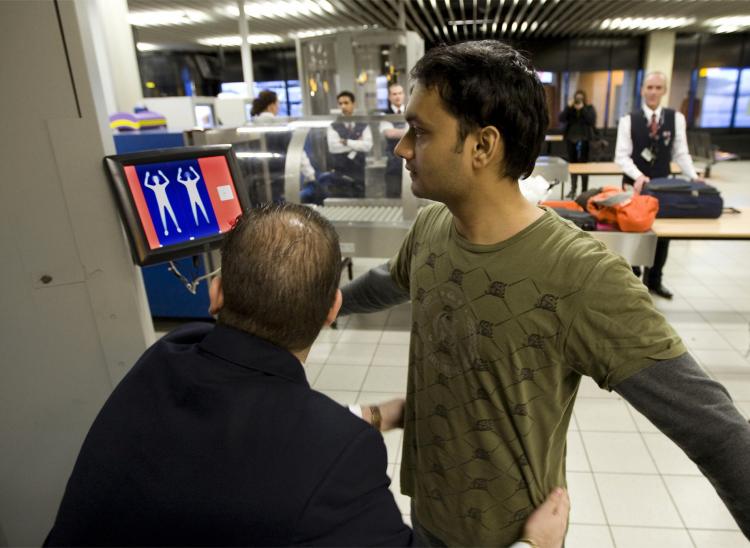Air travelers in Europe will once again be able to board a flight carrying their favorite traveler mug of coffee—in three years time.
The EU announced new measures to simplify and streamline aviation security in the eurozone on Thursday. A deadline was announced for the installment of new screening equipment in airports in the eurozone that can differentiate explosive liquids from water, lotion, syrup, toothpaste, and other harmless liquids.
“This package takes a significant step forward in signaling the beginning of the end for the current restrictions on liquids in cabin baggage, with a clear and final deadline of April 2013,” Siim Kallas, commission vice president in charge of transport, said in a press release.
After the 9/11 terrorist attacks in 2001, global aviation security measures dramatically tightened. Cockpit doors became bullet proof, flimsy plastic cutlery replaced silverware for in-flight meals and knitting needles became contraband.
Then in 2006, when U.K. police thwarted terrorists from blowing up a plane with liquid explosives in soft drink bottles, a ban was imposed on bringing on board any containers with a volume of more than 3 ounces (100 ml) of liquid.
The regulation led to a lot of passenger frustration as people were forced to dispose of water bottles, sun cream, expensive hair-loss tonic, or other non-threatening liquid items before boarding.
However, special liquid screening equipment that makes use of electro-magnetic waves to detect explosives will put an end to the hassle. The devise is already employed at Kansai International Airport in Japan where passengers can pop their pop bottles into a screening cradle and with one zap, their drink can be cleared for take off.
The devise is called Sencion, made by Sellex International headquartered in Columbus, Ohio.
“Flying today has become a hassle—luggage checks, carry-on exclusions and invasive personal searches. Though necessary, the process certainly is not comfortable or convenient for travelers,” said Sellex CEO Jerry Sellman, in an article on Gizmag.
The installment of such equipment is expected to shorten security wait times and in the long run will reduce aviation security costs. The Department of Homeland Security is also considering the devise for use on American flights.
Other measures the EU plans to implement are the elimination of double security checkpoints, simplifying and harmonizing procedures, and ensuring common minimum standards of security training for aviation security staff.
The EU announced new measures to simplify and streamline aviation security in the eurozone on Thursday. A deadline was announced for the installment of new screening equipment in airports in the eurozone that can differentiate explosive liquids from water, lotion, syrup, toothpaste, and other harmless liquids.
“This package takes a significant step forward in signaling the beginning of the end for the current restrictions on liquids in cabin baggage, with a clear and final deadline of April 2013,” Siim Kallas, commission vice president in charge of transport, said in a press release.
After the 9/11 terrorist attacks in 2001, global aviation security measures dramatically tightened. Cockpit doors became bullet proof, flimsy plastic cutlery replaced silverware for in-flight meals and knitting needles became contraband.
Then in 2006, when U.K. police thwarted terrorists from blowing up a plane with liquid explosives in soft drink bottles, a ban was imposed on bringing on board any containers with a volume of more than 3 ounces (100 ml) of liquid.
The regulation led to a lot of passenger frustration as people were forced to dispose of water bottles, sun cream, expensive hair-loss tonic, or other non-threatening liquid items before boarding.
However, special liquid screening equipment that makes use of electro-magnetic waves to detect explosives will put an end to the hassle. The devise is already employed at Kansai International Airport in Japan where passengers can pop their pop bottles into a screening cradle and with one zap, their drink can be cleared for take off.
The devise is called Sencion, made by Sellex International headquartered in Columbus, Ohio.
“Flying today has become a hassle—luggage checks, carry-on exclusions and invasive personal searches. Though necessary, the process certainly is not comfortable or convenient for travelers,” said Sellex CEO Jerry Sellman, in an article on Gizmag.
The installment of such equipment is expected to shorten security wait times and in the long run will reduce aviation security costs. The Department of Homeland Security is also considering the devise for use on American flights.
Other measures the EU plans to implement are the elimination of double security checkpoints, simplifying and harmonizing procedures, and ensuring common minimum standards of security training for aviation security staff.






Friends Read Free